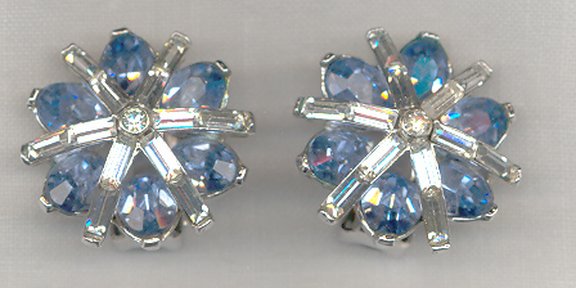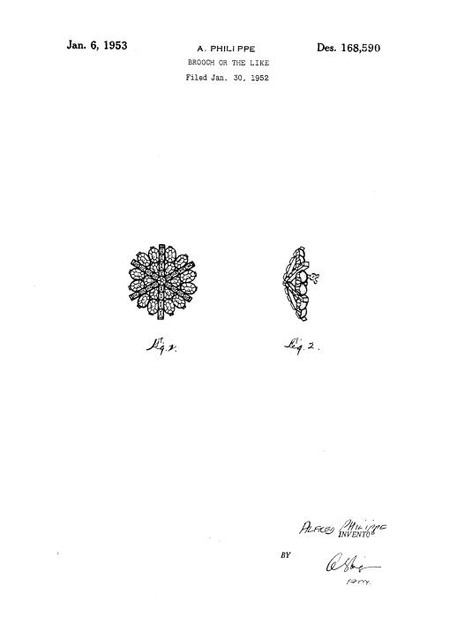The end of WWII brought the end of restrictions to the US but it was several years before European countries recovered from the War. In the mid-‘40’s the Paris couturiers gave their first post-War fashion show using wire dolls. The show was called Théâtre de la Mode and everything including the sets were done in miniature. The show was a great success and contributed to the preservation of couture in France. The collection has been permanently housed and preserved at the Maryhill Museum of Art in Goldendale, WA since 1952. The collection was restored in 1987 and went on a second tour in the early 1990's. I was fortunate to see it in the early '90's.
In 1947 Dior introduced The New Look which changed the way women dressed. The predominately slim fashion silhouette of the late ‘30’s through the war years changed to an idealized female silhouette with a tiny waist – padded hips and natural shoulders - and long full skirts!
Jewelry in the late '40's was still mostly Retro in style, but the scale gradually changed so that the pieces, many still asymmetrical, were smaller in scale - complimenting the new more feminine fashions. We looked at a little bit of late '40's Retro jewelry in Part IV. The Trifari Meteor parure is a good example.
In the late ‘40’s throughout the ‘50’s most costume jewelry was still very “real” looking. An important trend in fine jewelry, copied in costume, for the first time, was the separation of day-time and night-time jewelry. Jewelry set in goldtone finishes had colored stones but no diamonds – for day. "Cocktail" jewelry was worn in the evening.
This Boucher advertisement from 1956 shows a few great examples of this look as interpreted in costume jewelry:
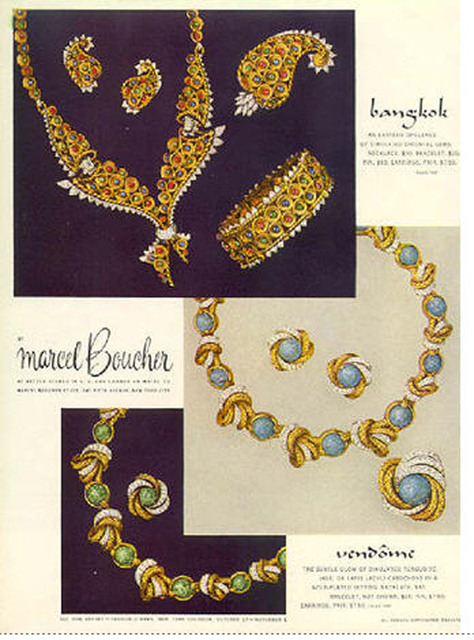
Some other examples:
Jomaz earrings- interesting color combination:
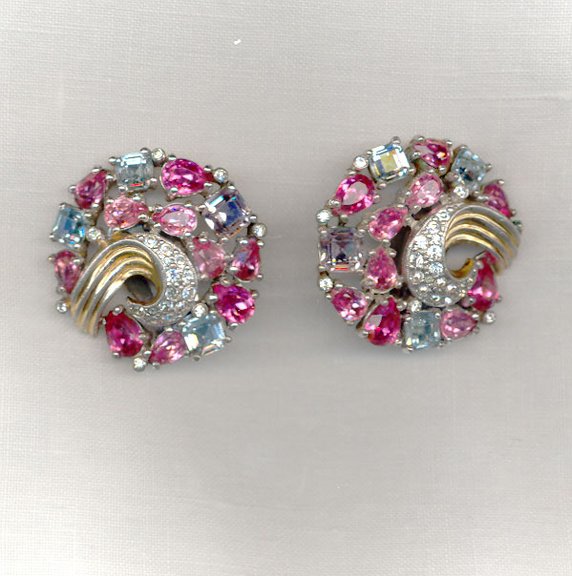
Trifari Brooch marked Pat. Pend:
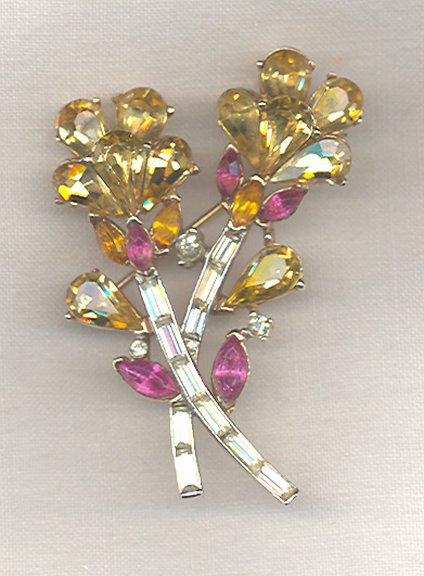
The two examples above do have "diamond" accents but are primarily colored stones and would have been worn during the day.
This example is by Weiss:
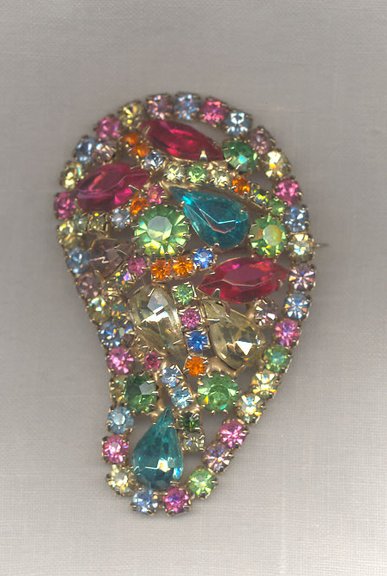
Here are some 1950's cocktail pieces:
Kramer:
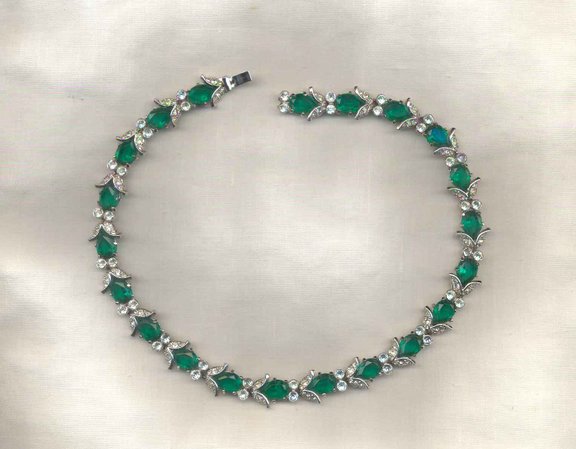
Pennino:
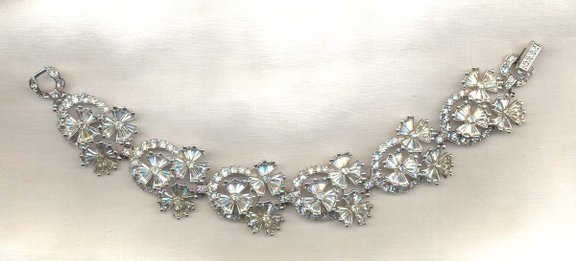
Late '40's earrings from Mazer:
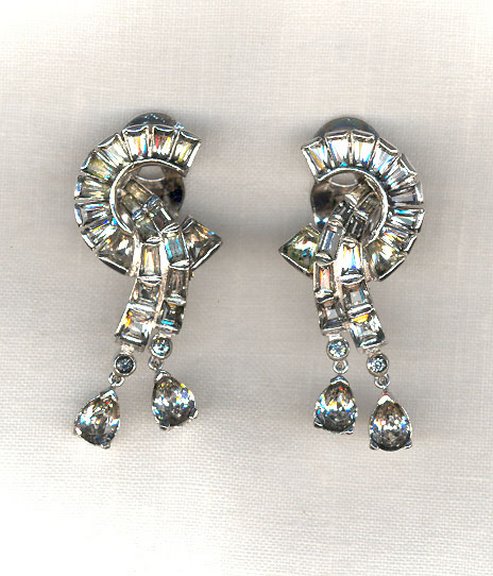
While most of the jewelry of the early '50's was real looking some of it was clearly "costume." What we now refer to as “prom” jewelry was first introduced after the War. The adjustable “J” hook necklace clasp was first used in the mid-late ‘40’s.
An example of 1950's Rhinestone "Prom" Jewelry:
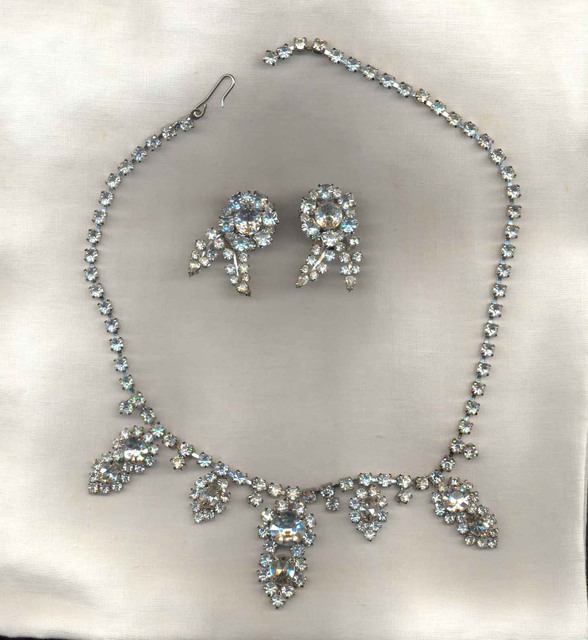
In the mid-‘50’s the process of vacuum coating rhinestones with an aurora borealis (AB) finish was perfected and introduced to the marketplace. Many costume jewelry manufacturers incorporated these new stones into their collections. These pieces of costume pieces jewelry no longer had “the real look” and were very clearly “glitz.”
Late '50's Vendome Earrings with AB and Colored Rhinestones. One characteristic of '50's earrings is the way the shape conforms to the ear. These are quite large!:
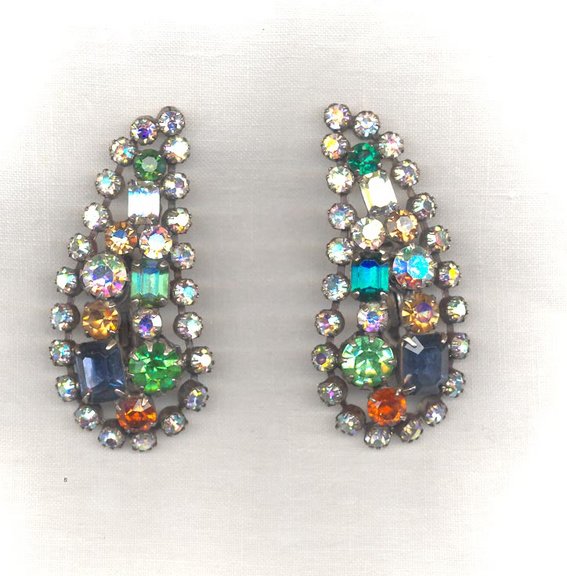
Dark rhinestones called “black” rhinestones were very popular in the late ‘50’s.
Weiss Black "Diamond" Earrings:
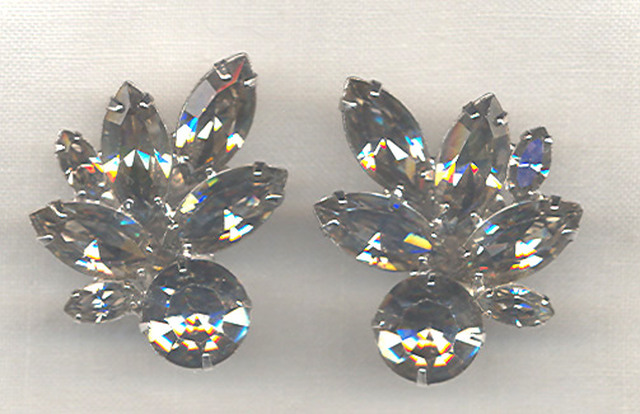
Another look that was worn in the early ‘50’s was the modernist look. Here is a chrome link bracelet from the 1950’s:
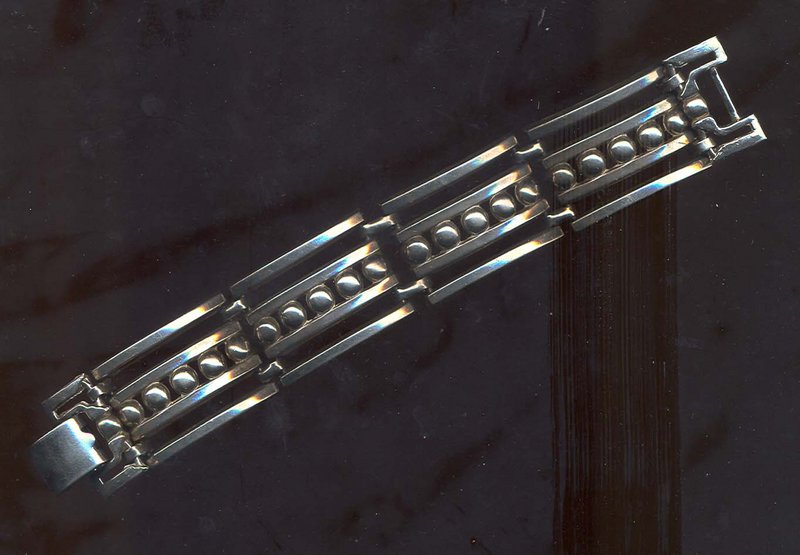
Some pieces were manufactured but many were one of a kind jewelry made by artisans in precious as well as non-precious metals, along with silver and pewter jewelry from Scandinavia. This jewelry would be a great topic for another workshop!
Also popular in the early – mid-‘50’s was copper and copper enamel jewelry. The most well known is by Renoir and Matisse. DIY kits were available so that you could make your own copper enamel jewelry (and ash trays) at home and in arts and crafts classes. (You had to take it somewhere to be fired.)
Matisse:
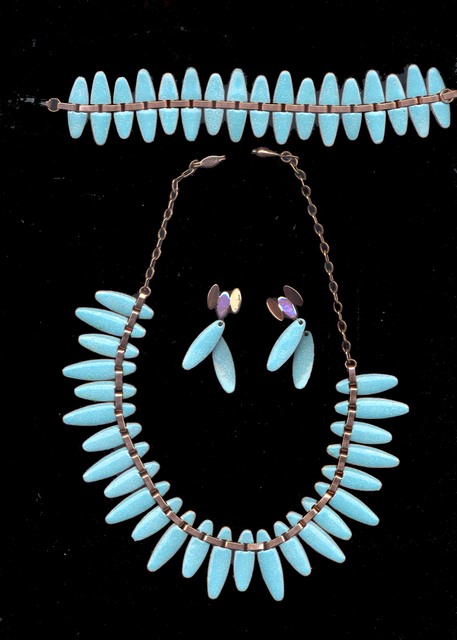
Beads and beaded jewelry was wildly popular throughout the 1950’s. By the beginning of the 1950’s Japan and Germany (then W. Germany) had re-kindled their jewelry industries. There are many beautiful multi-strand beaded necklaces, bracelets, and pairs of earrings from both countries that are frequently confused with similar designs from Miriam Haskell. Miriam Haskell jewelry was not signed until about 1950 so if you find jewelry with a filigree backing in the antique (Russian) gold color if it is Haskell, it will be signed.
Miriam Haskell brooch - C. 1950's:
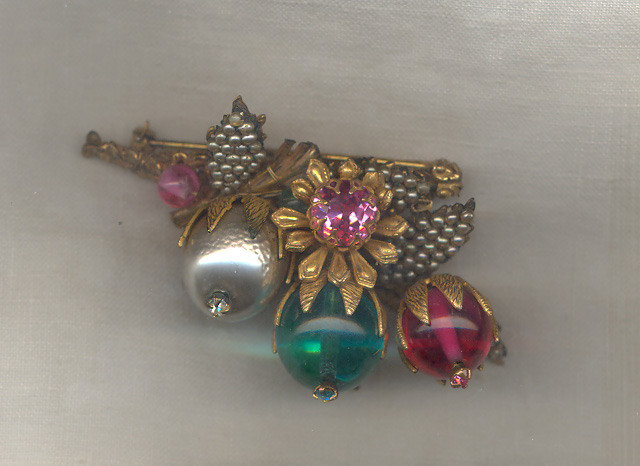
In addition to the New Look, long straight skirts were worn with fitted sweaters and jackets. These long straight skirts narrowed at the calf in the early ‘50’s making walking difficult – and are nicknamed wiggle skirts. Straight sheath dresses with narrow pencil skirts were also in fashion for much of the ‘50’s along with very full circle skirts. Fashion designers like Anne Fogarty designed for a very youthful figure with a tiny waist. Her look is called “The Paper Doll." Corsets and girdles were worn throughout this period –even with active sportswear! The 1950’s were a period of great prosperity in the U.S. It was also a time when women were encouraged to be stay at home wives and mothers. It is no wonder that “lady-like” real-look jewelry was in style. Think of all the 1950’s ads showing women doing housework in shirtwaist dresses, heels and pearls!
Let's look at the fashions of the Period we are discussing.
An iconic photo of The New Look:
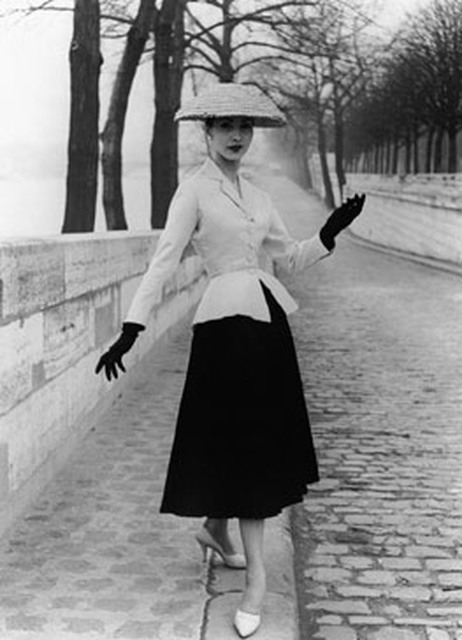
A Coat Ad from 1948:
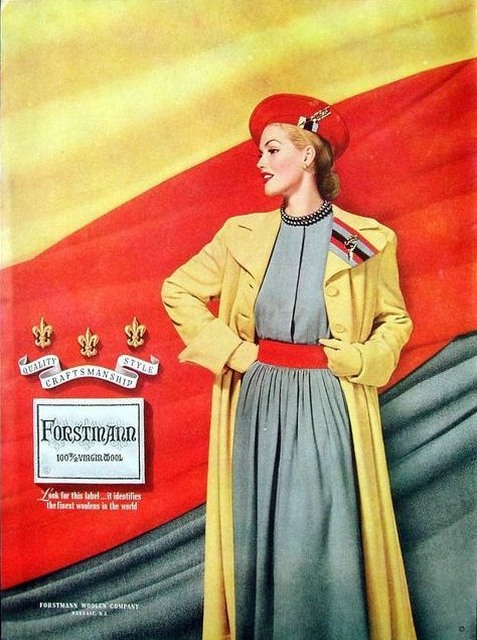
By 1951 there was an alternative to the full skirt:
Dior New York and Aywon Originals- a New York company:
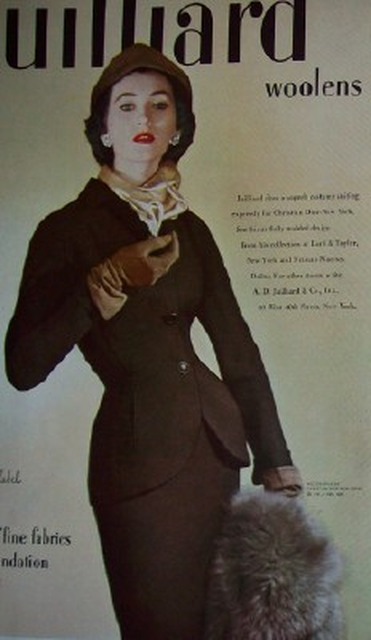
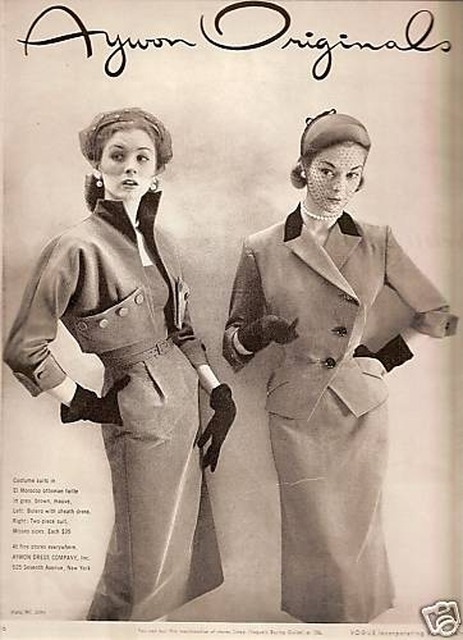
In the mid-'50's the look was either slim and tailored- Evan Picone, 1955:
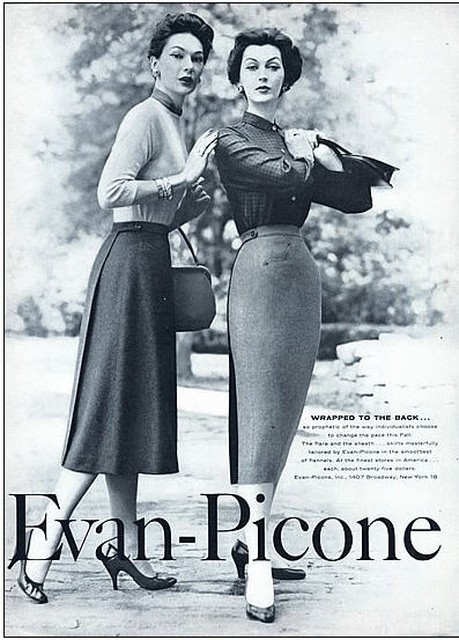
Or: Full and Feminine:
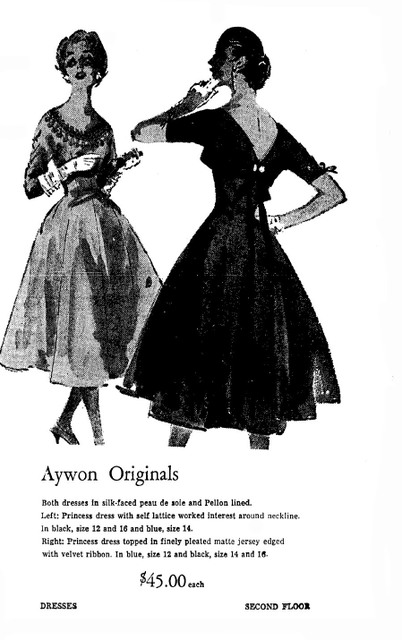
Of course any of us who remember the '50's will never forget the Poodle Skirt or the Circle Skirt:
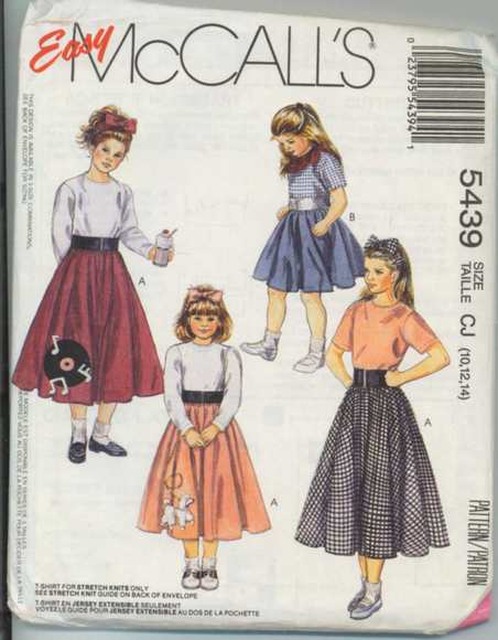
All of the ads feature women wearing hats, gloves and very tailored "lady-like" jewelry.
Here are some examples of "real" look late 1940's and early '50's jewelry - for day and evening.
Boucher - Night and Day Pin, D.151,029 - 1948. This opens and closes - and looks like fine jewelry.
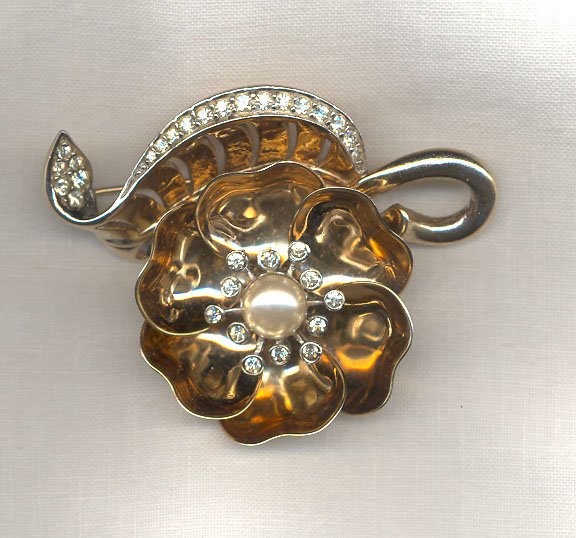
In the early ‘50’s there was still an interest in parures that continued through the ‘60’s.
Trifari "Claire de Lune" Parure - 1949
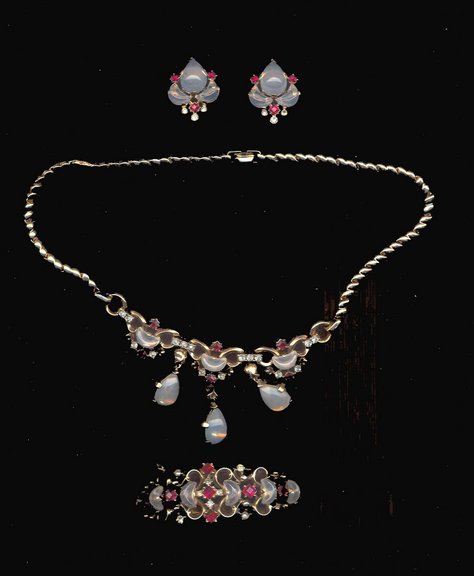
Trifari 1950's "Sapphire" Retro Necklace. Except for the closure this could be "real!" :
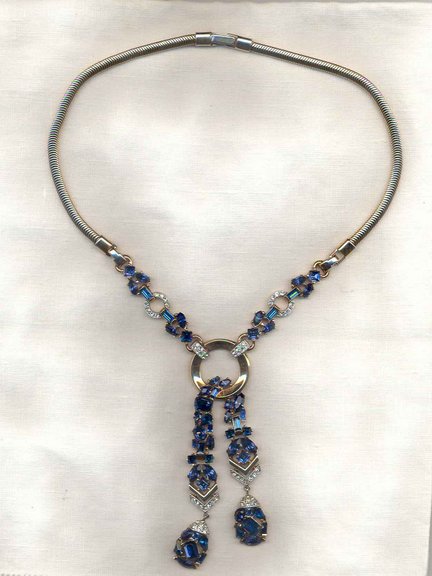
Unsigned Enamel and Faux carved Lapis and Faux Jade Brooch. Another good example of an interesting color combination. This would have been worn in the daytime:
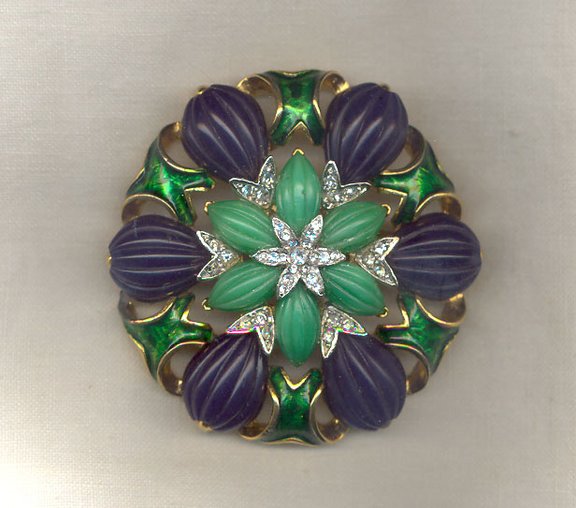
Jomaz:
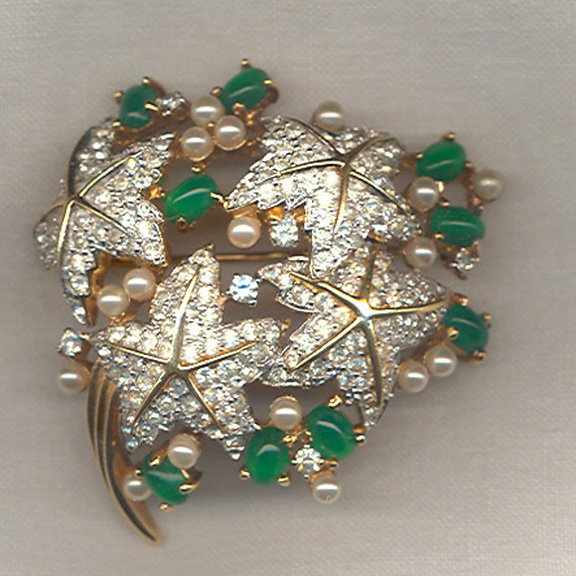
Jomaz is the name of the company formed by Joseph Mazer when Mazer Bros. split in the late 1940's. It's easy to picture Grace Kelly, one of the icons of the 1950's wearing this set.
Jomaz Parure:
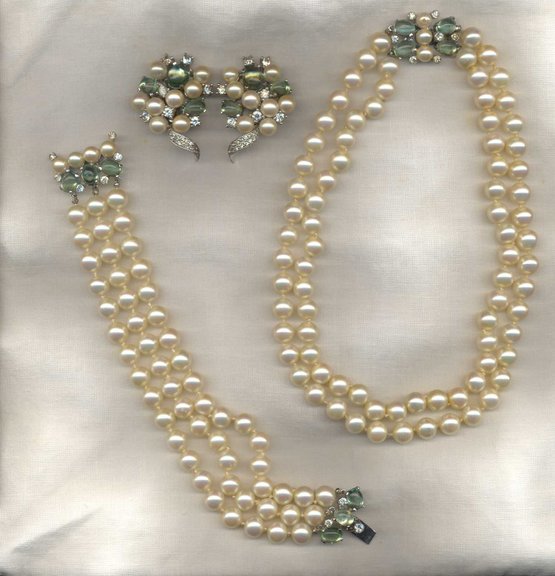
Jomaz Earrings and Kramer Pin:
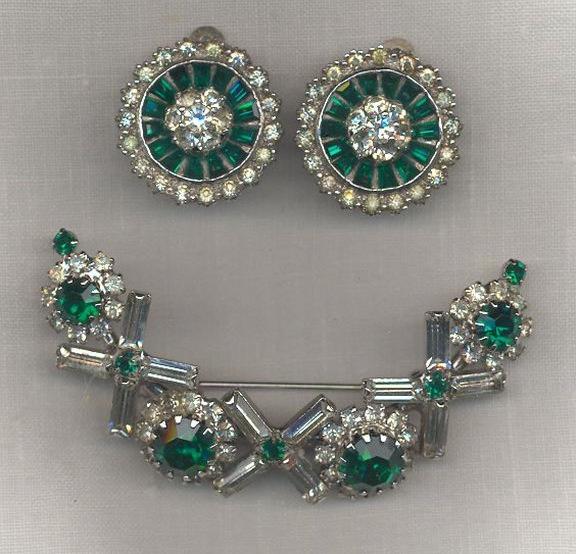
Jomaz Earrings:
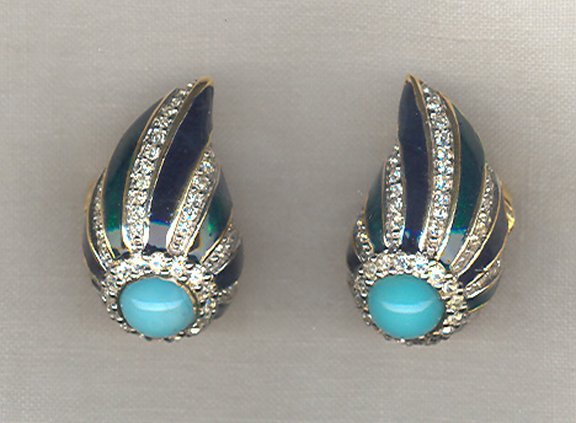
1950's Deco "Style" Chandelier Earrings:
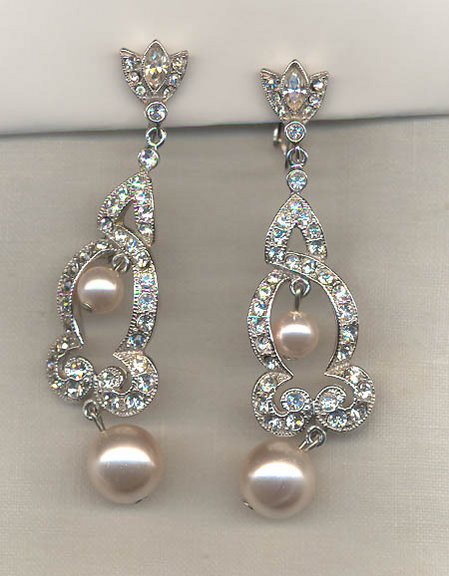
A 1950's Deco Style line bracelet. You can tell this is not "Period" because of the construction, and the weight but the quality is excellent. We discussed "revivals" in an earlier section of this workshop:
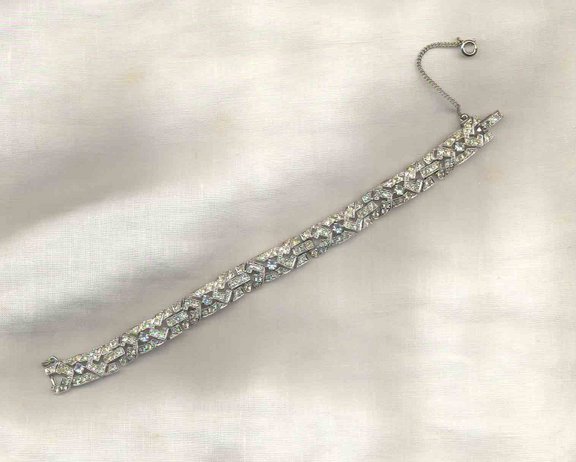
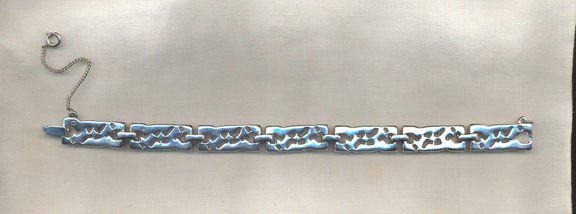
Textured fine gold jewelry, with a Florentine finish was seen frequently at the end of the 1950's. Here are some costume examples:
Trifari:
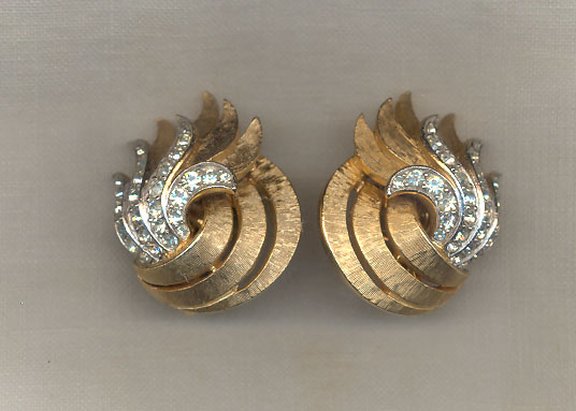
Jomaz:
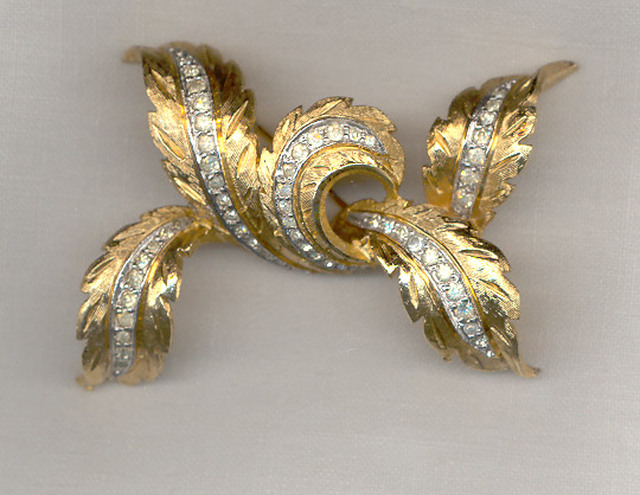
Vendome- the high end Coro line in the 1950's-1960's:
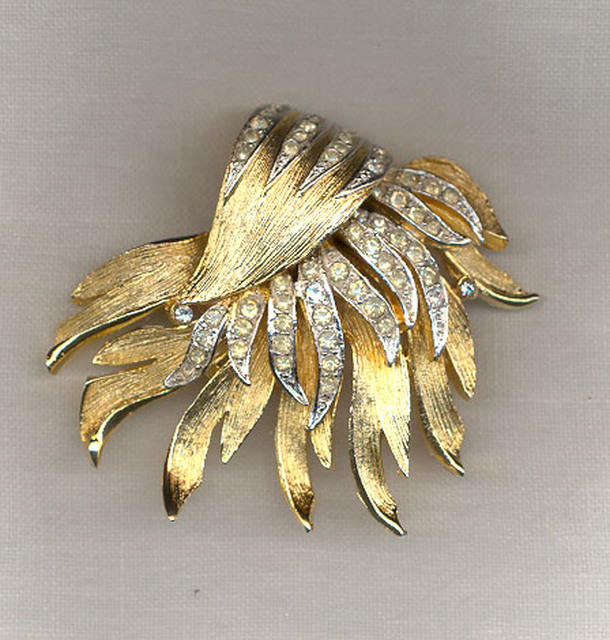
These earrings were made in 1954. They are marked with a Patent number for that year. Still "Retro" in style:
Trifari:
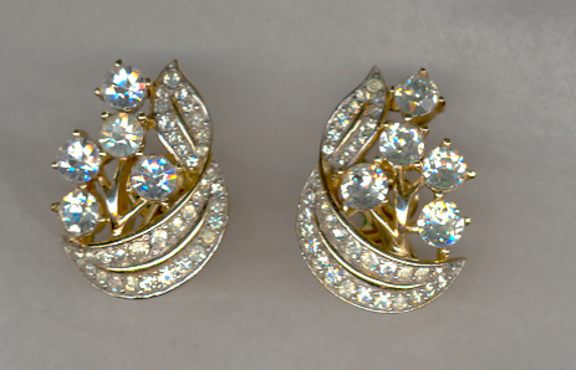
The backs are smooth and there is no © symbol:
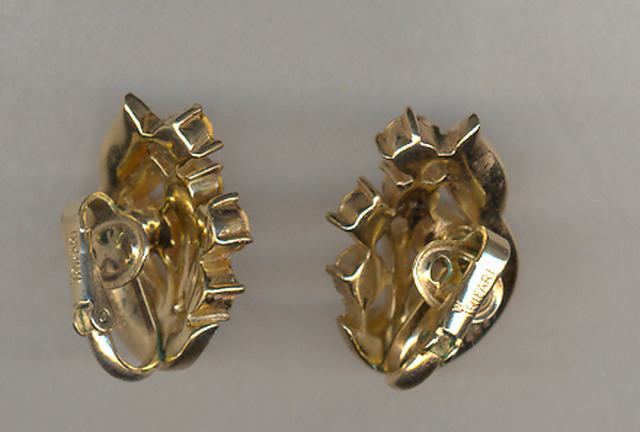
We mentioned that beads and beaded jewelry was very popular throughout the '50's.
Here's an unsigned multi-strand necklace with lampwork beads, Venetian bead and crystal beads:
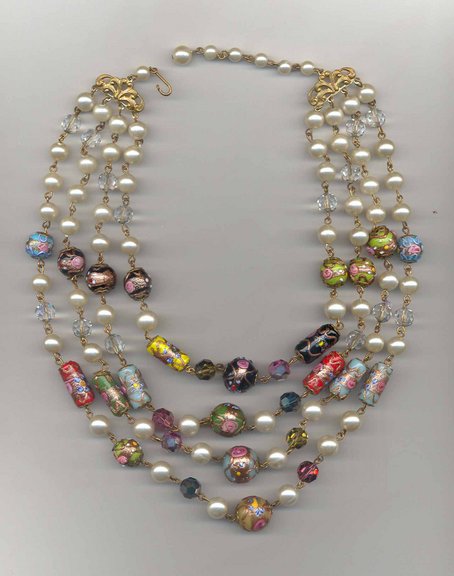
Crystal with Sterling clasp marked 835, the German mark for Sterling. C. 1950's:
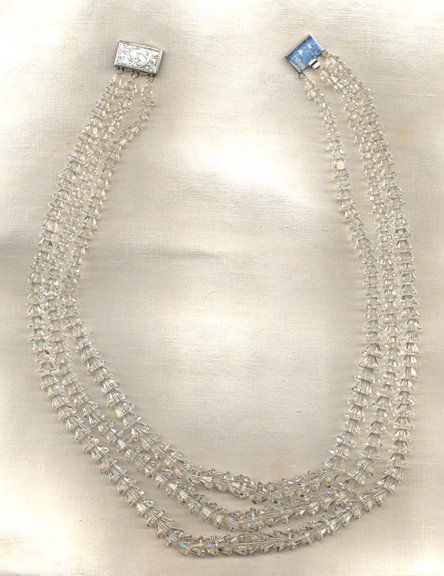
Crystal ab coated triple strand - unsigned. This type of clasp is typical of '50's beads.
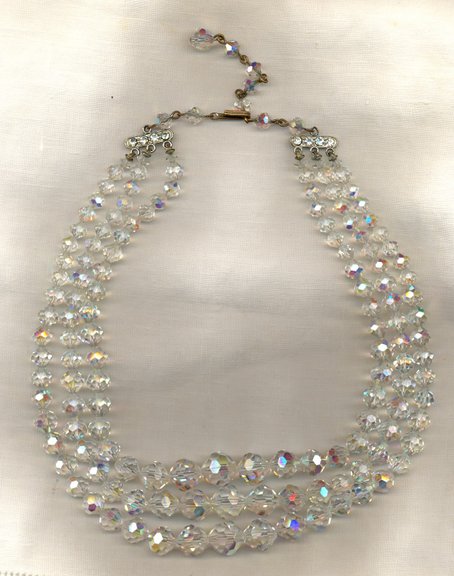 C. 1950's:
C. 1950's:
Black and white with beads signed Japan:
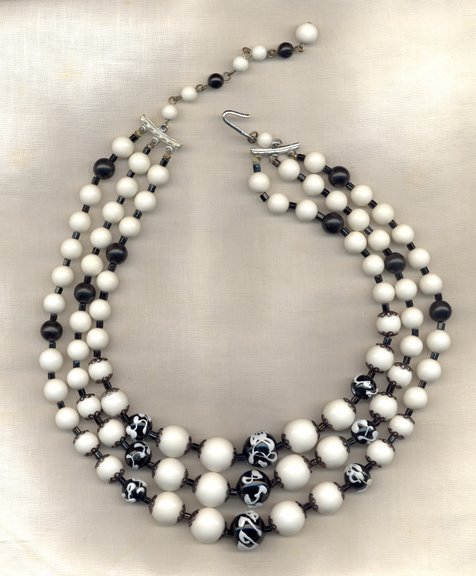
1950's Orange and White beads with earrings - probably from Japan - Unsigned:
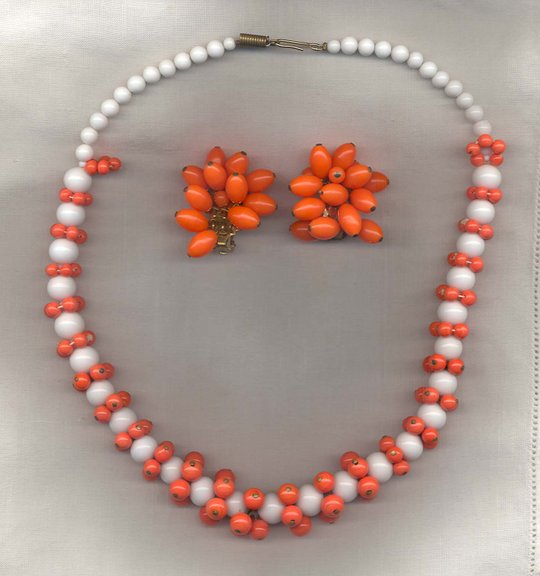
Some other major costume jewelry name from the '50's are Florenza, Hobé, Whiting and Davis, Hollycraft, and of course Coro:
Florenza:
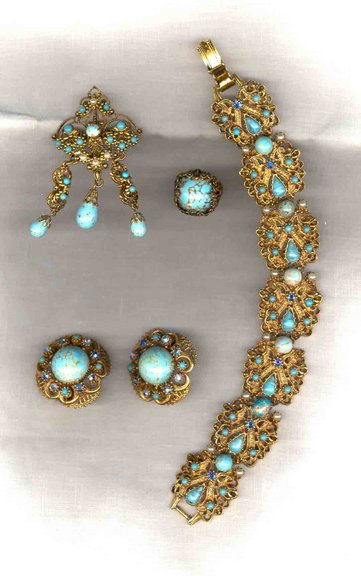
Hobé:
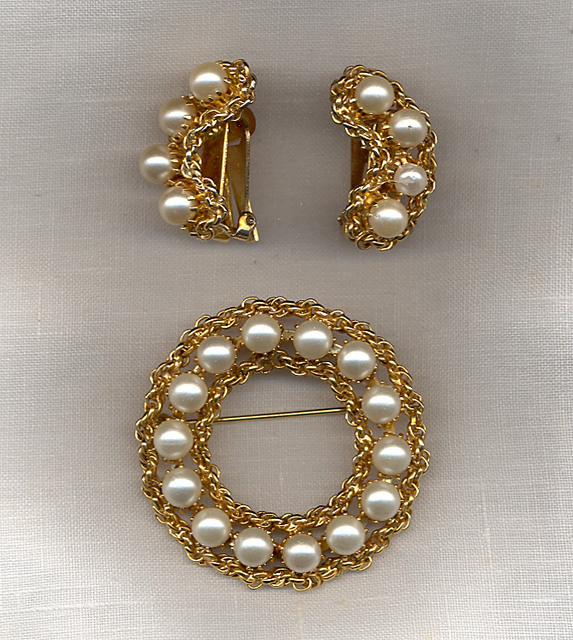
Whiting and Davis - Victorian Revival Style:

Hollycraft:
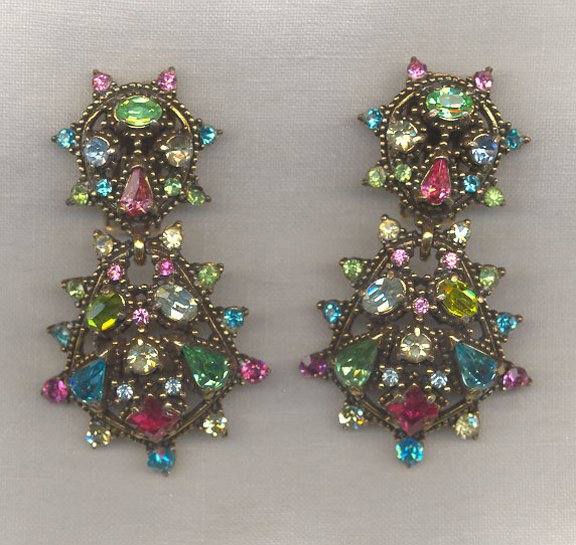
Coro:
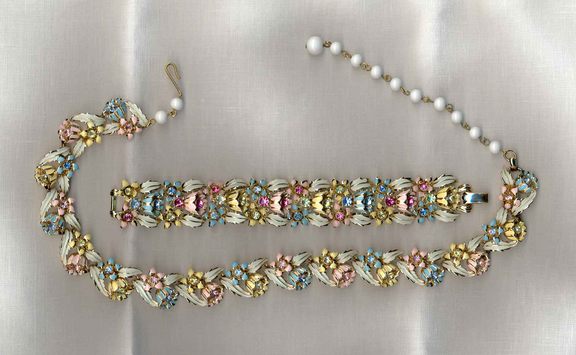
Many major names in costume jewelry did not manufacture their own pieces. They had exclusives in their lines but also purchased from lines that were shown in the marketplace. DeLizza and Elster - known for their line called Juliana sold to over 800 companies. Some of the companies that purchased their pieces were Weiss, Regency, Hattie Carnegie and many others.
Here are some pieces of late '50's - early '60's "glitzy" jewelry:
Unsigned:
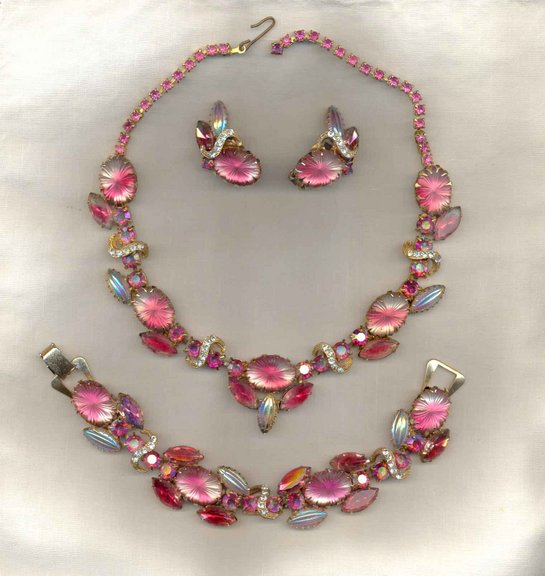
Weiss:
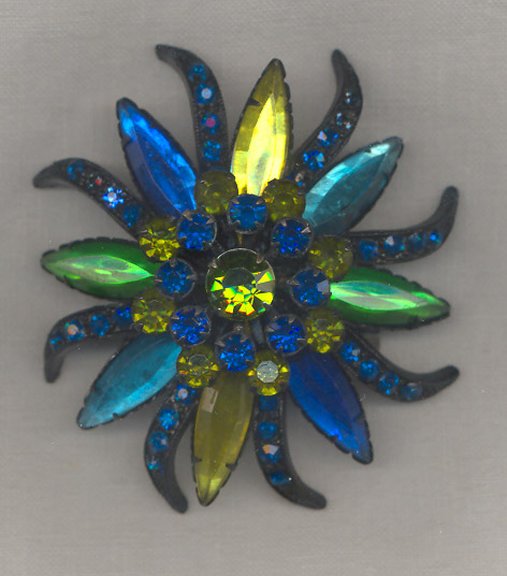
Hattie Carnegie:
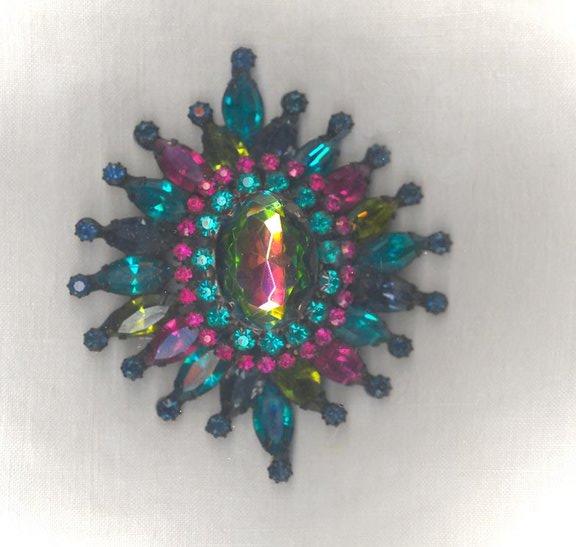
Unsigned Rivoli Brooch:
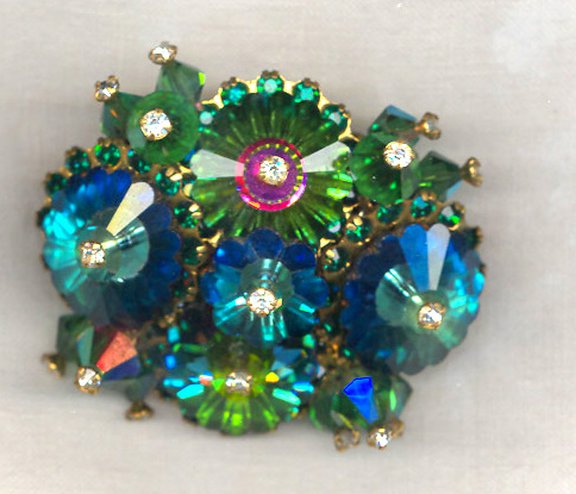
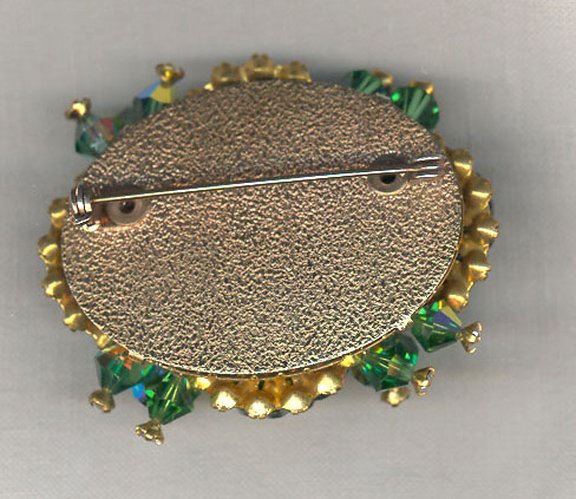
Unsigned Black Diamond, Aurora and Artglass (funky) earrings:
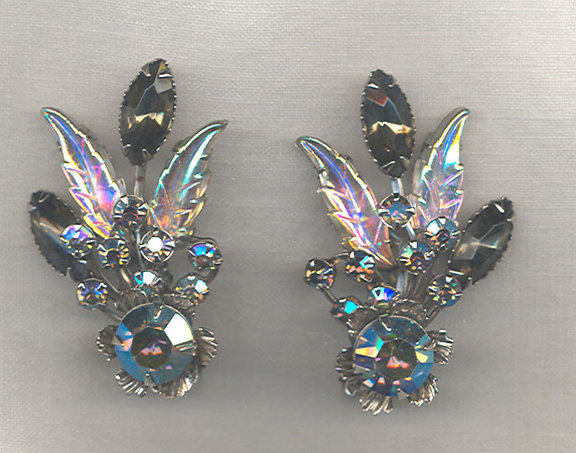
During the 1950's some jewelry had an "atomic" motif. Those of you old who are old enough might remember Air Raid drills where we "ducked and covered" under our desks at school. Here are some '50's "atomic" brooches - courtesy of "The Cold War":
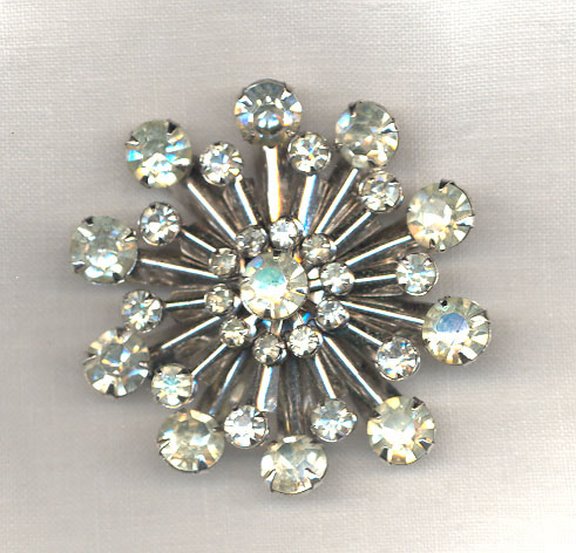
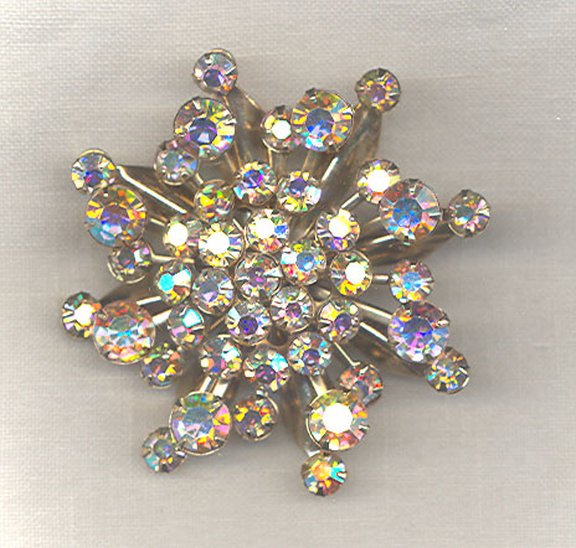
This brooch was made by Schreiner. It is unsigned but has the characteristic "hook" and "eye" construction that Schreiner used most of the time - and matches a necklace owned by one of my jewelry colleagues.

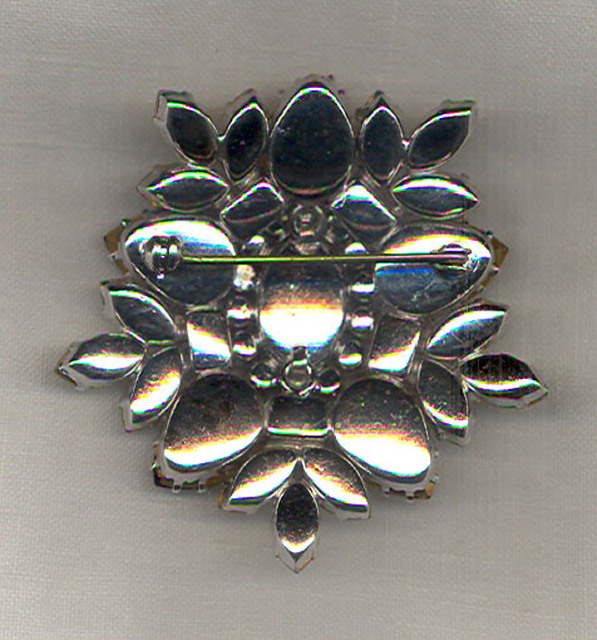
Sometimes only one one part of a parure is signed - and sometimes the signature is in an obscure place - like the inside of the "J" hook.
We'll look at some D&E aka Juliana shortly but first let's finish the '50's with a thermoplastic Kramer parure:
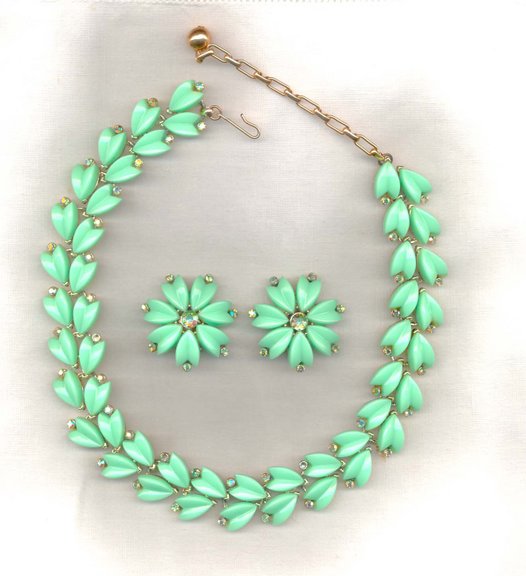
There is so much to say about plastic jewelry that it is a subject for another workshop. Here are a few more '50's plastic pieces:
Leru:
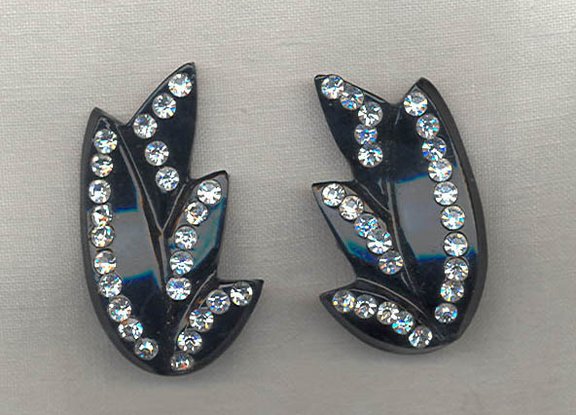
A C. 1950's Wide Bakelite Bangle with Plastic Inserts:
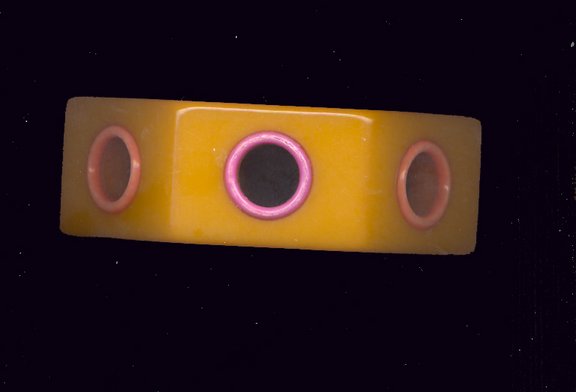
These remind me of "Swizzle Sticks"
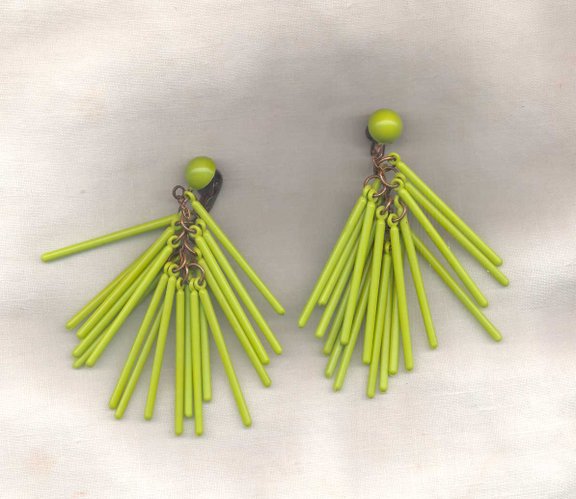
Let's look at a few 1950's jewelry ads and then we will move on to the 1960's. Vintage ads are a great way to trace the changes in fashion, hair and make-up trends so please take note of the dates of these ads.
Mazer 1951:
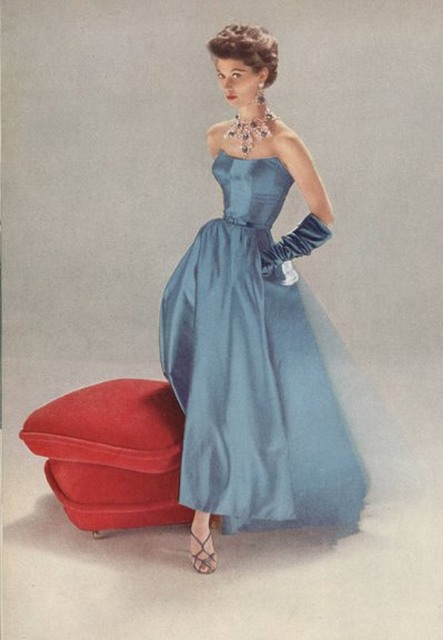
Max Factor 1952:
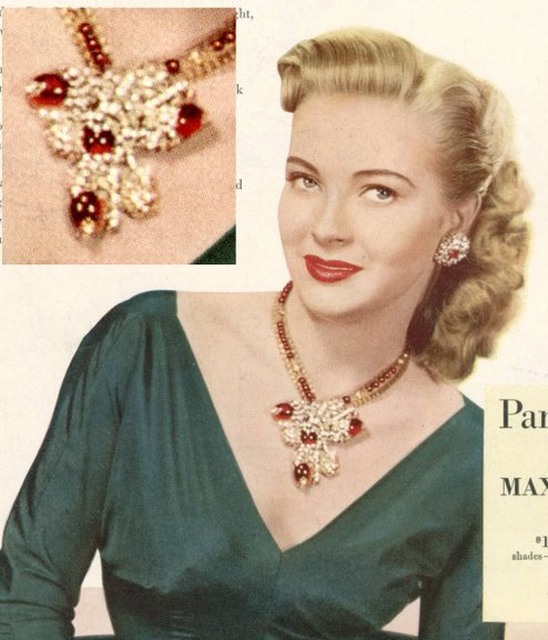
Miriam Haskell 1956:
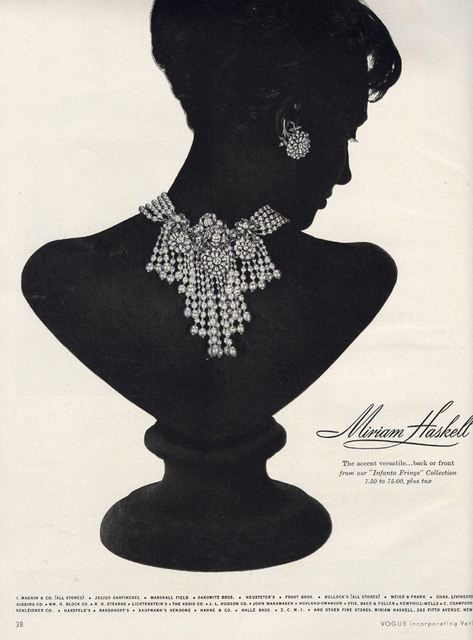
Bergere 1958:
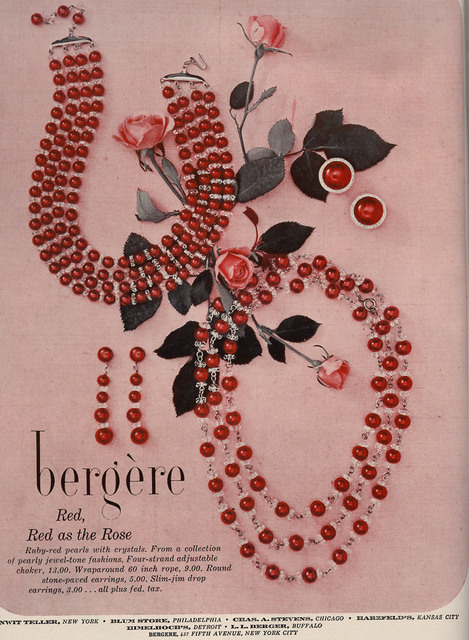
Castlecliff 1956:
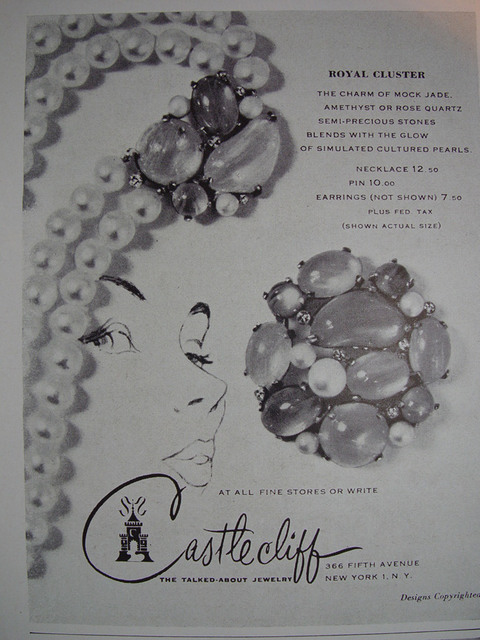
Coro 1955:

Coro 1958:
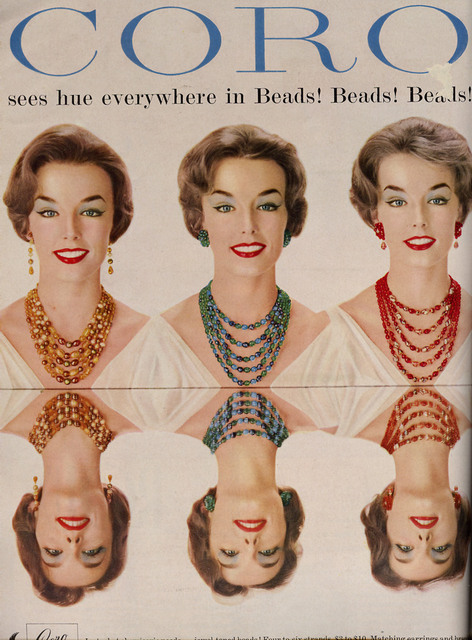
Eisenberg 1958:
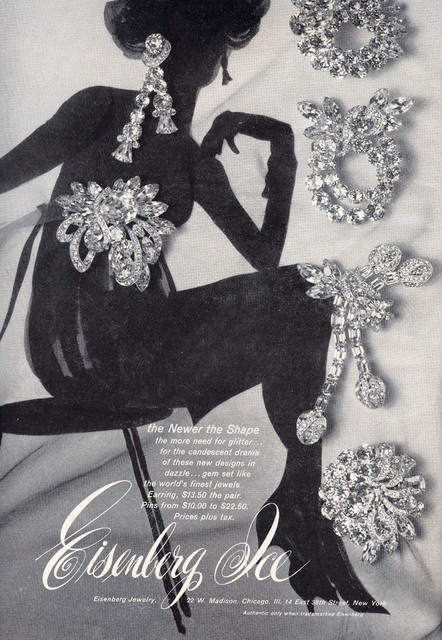
Unsigned Shoulder Duster Earrings:
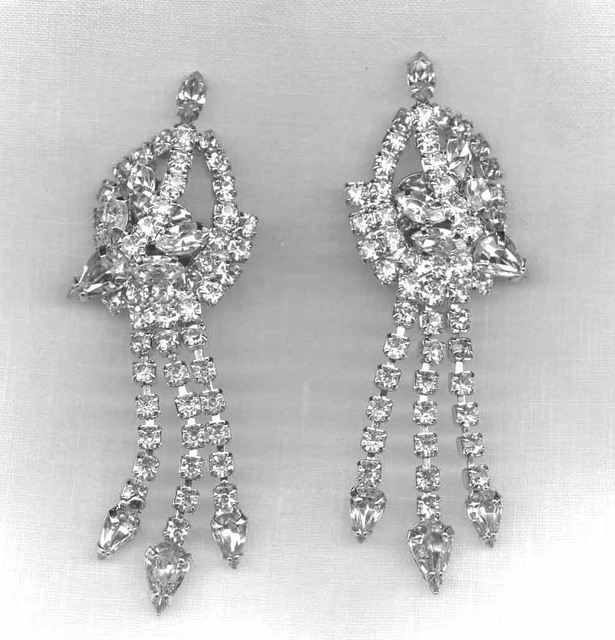
In the first part of the workshop we talked about how jewelry construction changed in the late 1950's. Most jewelry was no longer made in wax resist molds and hand finished but was made in rubber molds and spun cast. The backs were textured. Many companies marked their pieces with the © symbol. In addition while some pieces were still prong set - by hand, many stones were glued into "Faux" prong settings. At the end of the '50's into the '60's japanned finishes were very popular along with unusual combinations of stones and colors.
In the late'50's and during the '60's companies like D&E aka Juliana and other companies used unusual "artglass" stones or "bumpy" stones sometimes called "moonrocks."
Here are some D&E pieces. The larger stones are all prong set and the finishes are smooth.
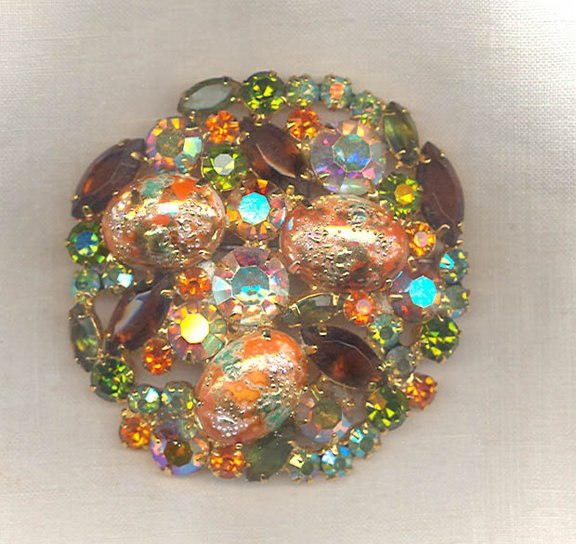
D&E Pink Rivoli Demi-Parure:
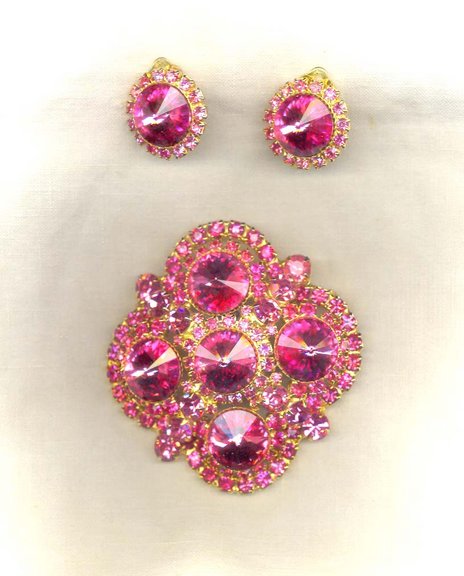
Unsigned - probably Regency:
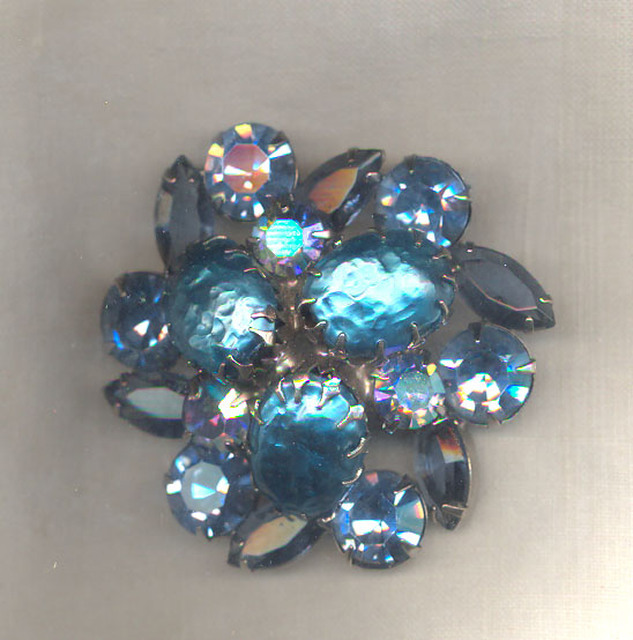
Unsigned:
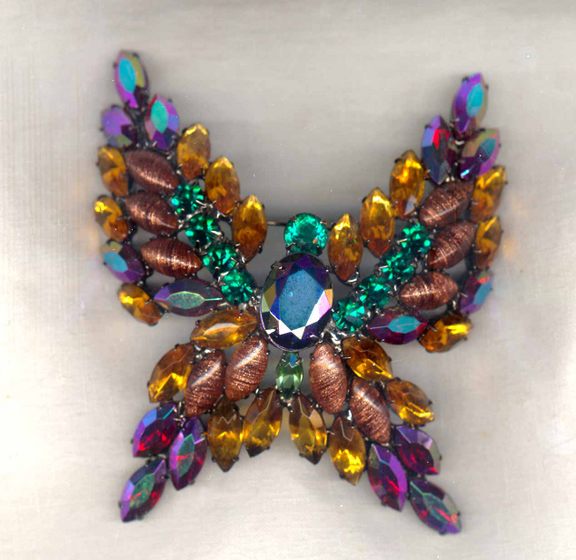
Here is an example of a late '50's- early '60's japanned brooch with "faux" prong set glued stones:
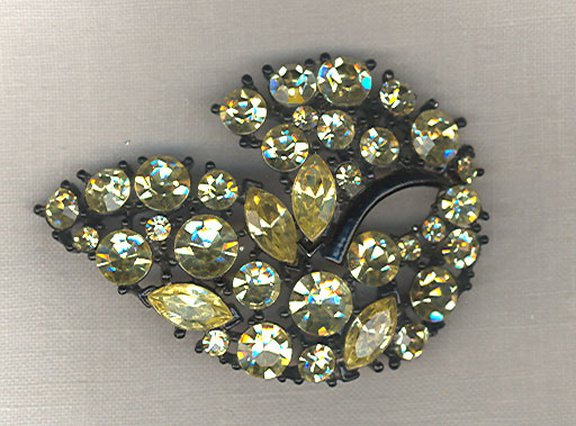
Another example of a "faux prong setting".
Art:
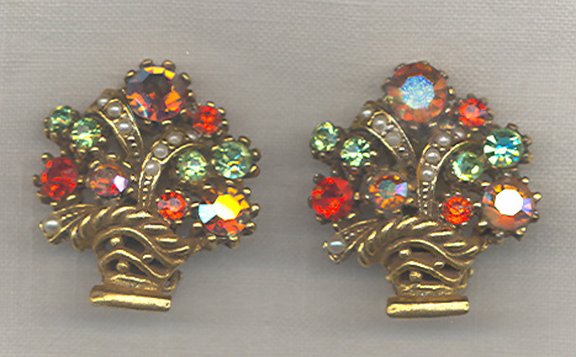
The '60's was a decade of tremendous social change. It was probably as - if not more turbulent than the period prior to and just after the First World War where we began our discussion of jewelry. In the U.S, the decade opened with the promise of the youthful President Kennedy and closed with the turmoil of student unrest, racial unrest, the Hippie Counter Culture, the Youth Movement, the Women's Movement and Vietnam.
Fashions in the early '60's evolved from and are similar to the late '50's - although hemlines are shorter. If you are a fan of "Mad Men" you have seen '60's fashions evolve from Season I which took place in 1960 to Season IV – which takes place in 1965. Betty Draper's flowered shirtwaist dresses have given way to shorter sheaths with our without matching jackets. By the mid-‘60’s, hemlines were creeping up, pantyhose had replaced girdles and garter belts, and women were no longer wore corsets to cinch their waists. Women were expressing this newfound freedom in many ways!
Fashion and jewelry are always influenced by the events of the day. As the '60's unfolded, the fashionable designer look worn by Jackie Kennedy and imitated by women everywhere gave way - especially in the younger generation to the "Mod Look" and the mini followed by the micro-mini then the maxi over hot-pants. It was the time of psychedelic prints and strange color combinations - long dangly earrings made of unusual materials – large scale necklaces contrasted by the plain gold look.
Jewelry makers could barely keep up with the constant changes and while traditional fine jewelry has never gone out of favor, costume jewelry of the mid-late '60's is a potpourri of many influences including rock music, the youth movement, the counter culture, and various ethnic influences.
Costume jewelry in the very late 1950's either still imitated fine jewelry or was clearly "costume" with stones and finishes not found in nature.
During the 1950's and 1960's three women stand out as fashion icons. They are Princess Grace, Audrey Hepburn and Jackie Kennedy (Onassis.) We can easily picture each of their looks - particularly Audrey in "Breakfast at Tiffany's" with diamonds in her hair and Jackie and Princess Grace in tasteful pearls and small brooches.
Let's take a look at several jewelry ads from 1959 - 1966. Be sure to look not just at the changes in the jewelry and fashion but the changes in hairstyle and make-up.
Jomaz 1959:
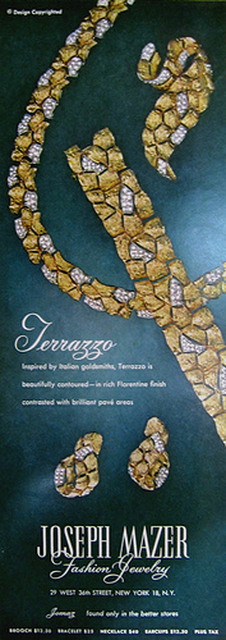
Weiss 1959:
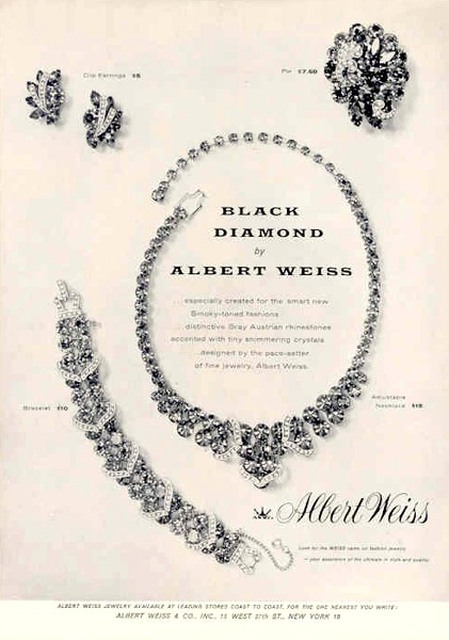
These two ads represent the "Real Look" and the "Faux Glitzy Rhinestone" look that were both in fashion at the same time.
Trifari 1963. Although this ad is dated 1963, the jewelry is representative of pieces made throughout the rest of the decade:
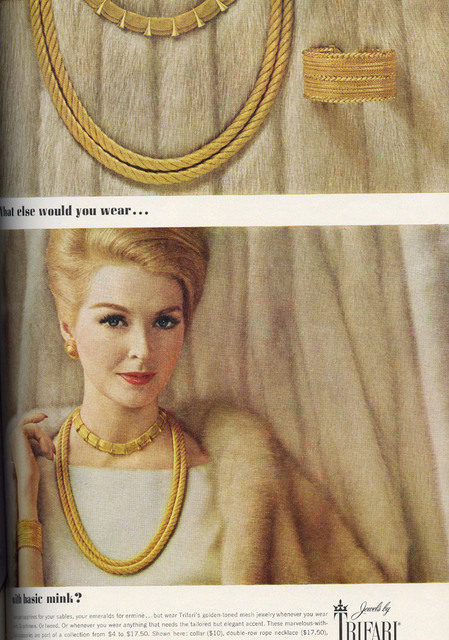
Trifari 1964:
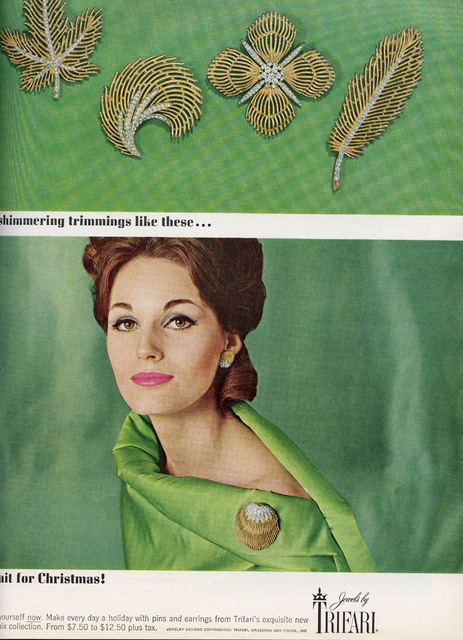
One of the pieces in the ad. This piece still has a smooth back and is very representative of ladylike real looking jewelry.
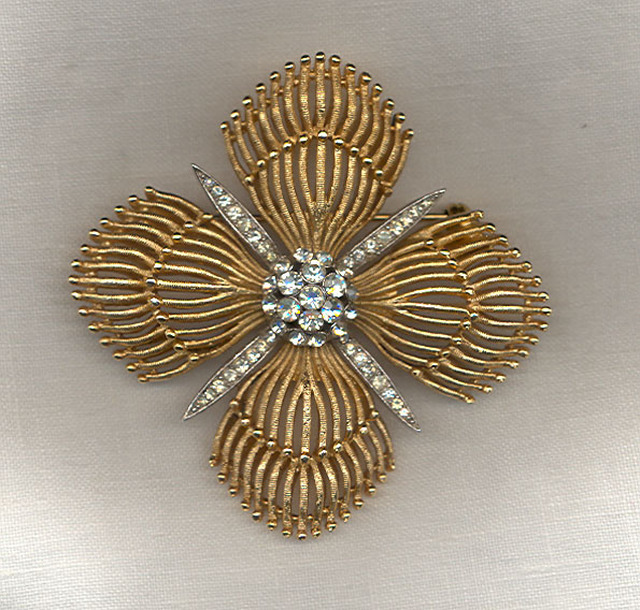
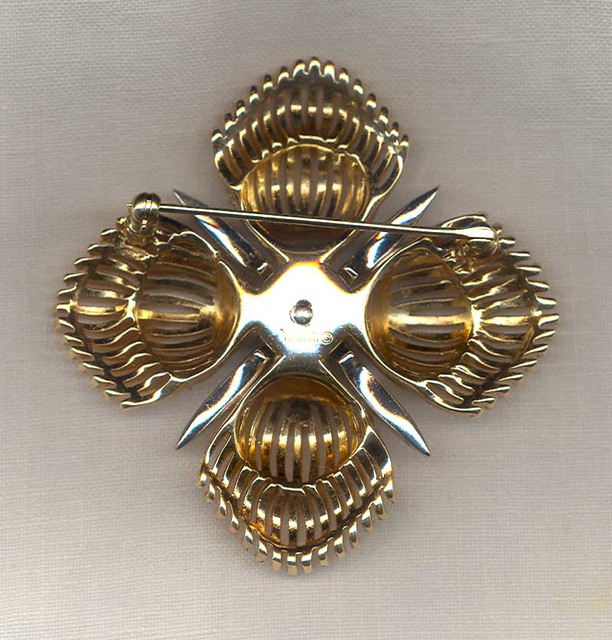
Marvella 1964:
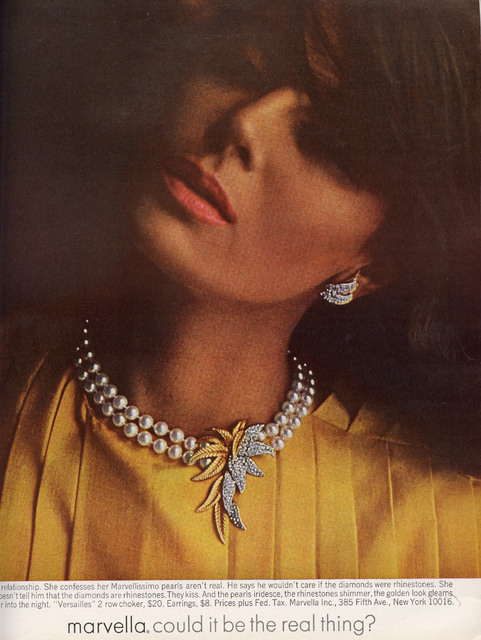
Vendome 1964:
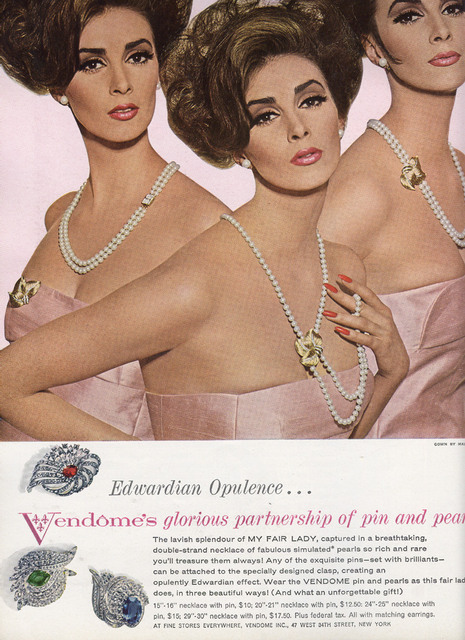
It's "interesting" and somewhat ironic that this collection was called "Edwardian" which is where we began. While the jewelry is pretty - it doesn't resemble the diamond and pearl filligree jewelry that was worn 60 years earlier.
Eisenberg 1965:
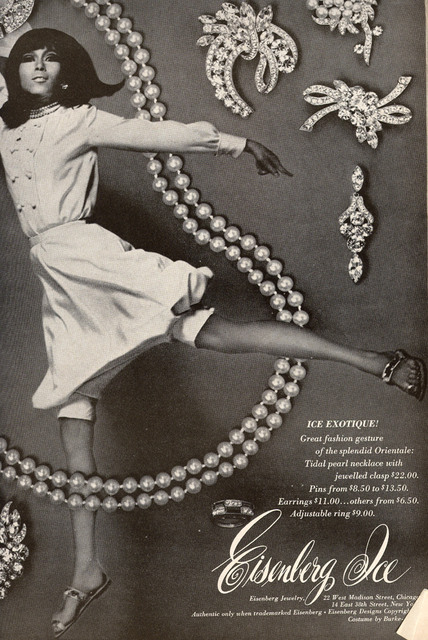
The jewelry is pretty conservative and representative of Eisenberg but the model is wearing more au courant make-up, hairstyle and clothing!
Richelieu 1966:
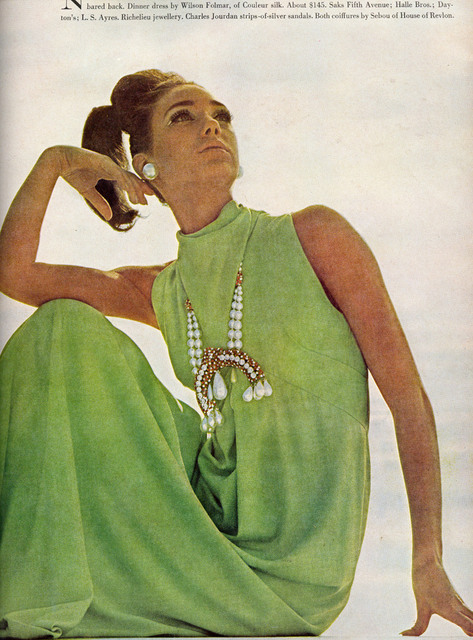
This one is a precursor to the end of the decade and the Maxi. The jewelry is no longer ladylike or dainty but bold and seems to be influenced by ethnic jewelry done in tradtional materials.
Vendome 1966.
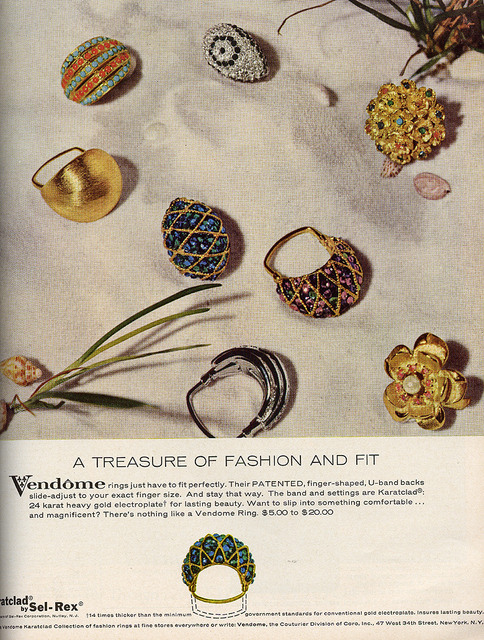
By contrast I'd like to share a costume ring C.1930 set in sterling. The workmanship is amazing!
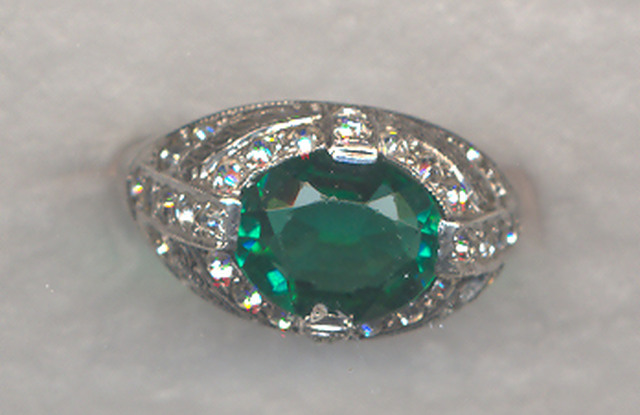
My personal feeling about the jewelry shown in the ad above and the previous one is that these pieces are not "beautiful" or beautifully made, but rather ordinary and commercial. Within a few years after these pieces were made, most jewelry sold by American companies was made off-shore, most of the remaining jewelry made was costume imitations of the gold chains and earrings that were shown in fine jewelry.
Glitzy costume jewelry - like D&E continued to be produced until the end of the decade. DeLizza and Elster continued making jewelry until 1990 and recently began reissuing some of their classic designs. Weiss was in business until 1971. Kenneth J. Lane started making jewelry in 1963 and is still in business today and some of the major costume jewelry companies like Coro lasted another decade after the ‘60’s. Coro closed in 1979. Trifari was purchased by Hallmark in 1975, and later became part of the Monet group. The Monet group which includes Trifari and Marvella was last sold to Liz Claiborne, Inc. in 2000 and at that time production was moved off-shore. Napier closed in 1999. If you stroll through any major department store today, you will find racks of sparkly costume jewelry some with expensive price tags but the quality and design are very different from the exciting pieces produced from the 1930's through the early 1950's.
Very little jewelry is made in the U.S. in the 21C. Most of the factories in Providence have been closed for many years. One company that is still in business and making their own line - and jewelry for others - is Gem-Craft - owned by Ron Verri and his father, Gene Verri (Gene Verrecchia of Coro fame.)
Before we conclude, I'd like to share some "tips" on what to look for when you shop - either for yourself or for resale.
1. Design – Does it SPEAK to you?
2. Quality and Constructions – Is it a “good” piece? Is it Signed?
3. Overall Condition – Any visible damage or repairs?
4. Stones - Sparkly and clear? Any dead, dull or missing?
5. Pin backs secure? Clasps and Catches work?
6. Are the prongs on stones tight and intact?
7. Are glued stones secure?
8. Does any excess glue show?
9. Price –depends on if it’s a “keeper” or for resale
It’s always a good idea to try on bracelets and necklaces to make sure they fit. Try on both earrings to make sure that they stay on your ears and flatter you!
And most important if you are buying the piece to keep – does it fit into your collection and will you wear if???
This concludes the workshop. I hope you have enjoyed it as much as enjoyed putting it together!
Linn
In 1947 Dior introduced The New Look which changed the way women dressed. The predominately slim fashion silhouette of the late ‘30’s through the war years changed to an idealized female silhouette with a tiny waist – padded hips and natural shoulders - and long full skirts!
Jewelry in the late '40's was still mostly Retro in style, but the scale gradually changed so that the pieces, many still asymmetrical, were smaller in scale - complimenting the new more feminine fashions. We looked at a little bit of late '40's Retro jewelry in Part IV. The Trifari Meteor parure is a good example.
In the late ‘40’s throughout the ‘50’s most costume jewelry was still very “real” looking. An important trend in fine jewelry, copied in costume, for the first time, was the separation of day-time and night-time jewelry. Jewelry set in goldtone finishes had colored stones but no diamonds – for day. "Cocktail" jewelry was worn in the evening.
This Boucher advertisement from 1956 shows a few great examples of this look as interpreted in costume jewelry:

Some other examples:
Jomaz earrings- interesting color combination:

Trifari Brooch marked Pat. Pend:

The two examples above do have "diamond" accents but are primarily colored stones and would have been worn during the day.
This example is by Weiss:

Here are some 1950's cocktail pieces:
Kramer:

Pennino:

Late '40's earrings from Mazer:

While most of the jewelry of the early '50's was real looking some of it was clearly "costume." What we now refer to as “prom” jewelry was first introduced after the War. The adjustable “J” hook necklace clasp was first used in the mid-late ‘40’s.
An example of 1950's Rhinestone "Prom" Jewelry:

In the mid-‘50’s the process of vacuum coating rhinestones with an aurora borealis (AB) finish was perfected and introduced to the marketplace. Many costume jewelry manufacturers incorporated these new stones into their collections. These pieces of costume pieces jewelry no longer had “the real look” and were very clearly “glitz.”
Late '50's Vendome Earrings with AB and Colored Rhinestones. One characteristic of '50's earrings is the way the shape conforms to the ear. These are quite large!:

Dark rhinestones called “black” rhinestones were very popular in the late ‘50’s.
Weiss Black "Diamond" Earrings:

Another look that was worn in the early ‘50’s was the modernist look. Here is a chrome link bracelet from the 1950’s:

Some pieces were manufactured but many were one of a kind jewelry made by artisans in precious as well as non-precious metals, along with silver and pewter jewelry from Scandinavia. This jewelry would be a great topic for another workshop!
Also popular in the early – mid-‘50’s was copper and copper enamel jewelry. The most well known is by Renoir and Matisse. DIY kits were available so that you could make your own copper enamel jewelry (and ash trays) at home and in arts and crafts classes. (You had to take it somewhere to be fired.)
Matisse:

Beads and beaded jewelry was wildly popular throughout the 1950’s. By the beginning of the 1950’s Japan and Germany (then W. Germany) had re-kindled their jewelry industries. There are many beautiful multi-strand beaded necklaces, bracelets, and pairs of earrings from both countries that are frequently confused with similar designs from Miriam Haskell. Miriam Haskell jewelry was not signed until about 1950 so if you find jewelry with a filigree backing in the antique (Russian) gold color if it is Haskell, it will be signed.
Miriam Haskell brooch - C. 1950's:

In addition to the New Look, long straight skirts were worn with fitted sweaters and jackets. These long straight skirts narrowed at the calf in the early ‘50’s making walking difficult – and are nicknamed wiggle skirts. Straight sheath dresses with narrow pencil skirts were also in fashion for much of the ‘50’s along with very full circle skirts. Fashion designers like Anne Fogarty designed for a very youthful figure with a tiny waist. Her look is called “The Paper Doll." Corsets and girdles were worn throughout this period –even with active sportswear! The 1950’s were a period of great prosperity in the U.S. It was also a time when women were encouraged to be stay at home wives and mothers. It is no wonder that “lady-like” real-look jewelry was in style. Think of all the 1950’s ads showing women doing housework in shirtwaist dresses, heels and pearls!
Let's look at the fashions of the Period we are discussing.
An iconic photo of The New Look:

A Coat Ad from 1948:

By 1951 there was an alternative to the full skirt:
Dior New York and Aywon Originals- a New York company:


In the mid-'50's the look was either slim and tailored- Evan Picone, 1955:
Or: Full and Feminine:

Of course any of us who remember the '50's will never forget the Poodle Skirt or the Circle Skirt:

All of the ads feature women wearing hats, gloves and very tailored "lady-like" jewelry.
Here are some examples of "real" look late 1940's and early '50's jewelry - for day and evening.
Boucher - Night and Day Pin, D.151,029 - 1948. This opens and closes - and looks like fine jewelry.

In the early ‘50’s there was still an interest in parures that continued through the ‘60’s.
Trifari "Claire de Lune" Parure - 1949

Trifari 1950's "Sapphire" Retro Necklace. Except for the closure this could be "real!" :

Unsigned Enamel and Faux carved Lapis and Faux Jade Brooch. Another good example of an interesting color combination. This would have been worn in the daytime:

Jomaz:

Jomaz is the name of the company formed by Joseph Mazer when Mazer Bros. split in the late 1940's. It's easy to picture Grace Kelly, one of the icons of the 1950's wearing this set.
Jomaz Parure:

Jomaz Earrings and Kramer Pin:

Jomaz Earrings:

1950's Deco "Style" Chandelier Earrings:

A 1950's Deco Style line bracelet. You can tell this is not "Period" because of the construction, and the weight but the quality is excellent. We discussed "revivals" in an earlier section of this workshop:


Textured fine gold jewelry, with a Florentine finish was seen frequently at the end of the 1950's. Here are some costume examples:
Trifari:

Jomaz:

Vendome- the high end Coro line in the 1950's-1960's:

These earrings were made in 1954. They are marked with a Patent number for that year. Still "Retro" in style:
Trifari:

The backs are smooth and there is no © symbol:

We mentioned that beads and beaded jewelry was very popular throughout the '50's.
Here's an unsigned multi-strand necklace with lampwork beads, Venetian bead and crystal beads:

Crystal with Sterling clasp marked 835, the German mark for Sterling. C. 1950's:

Crystal ab coated triple strand - unsigned. This type of clasp is typical of '50's beads.

Black and white with beads signed Japan:

1950's Orange and White beads with earrings - probably from Japan - Unsigned:

Some other major costume jewelry name from the '50's are Florenza, Hobé, Whiting and Davis, Hollycraft, and of course Coro:
Florenza:

Hobé:

Whiting and Davis - Victorian Revival Style:

Hollycraft:

Coro:

Many major names in costume jewelry did not manufacture their own pieces. They had exclusives in their lines but also purchased from lines that were shown in the marketplace. DeLizza and Elster - known for their line called Juliana sold to over 800 companies. Some of the companies that purchased their pieces were Weiss, Regency, Hattie Carnegie and many others.
Here are some pieces of late '50's - early '60's "glitzy" jewelry:
Unsigned:

Weiss:

Hattie Carnegie:

Unsigned Rivoli Brooch:


Unsigned Black Diamond, Aurora and Artglass (funky) earrings:

During the 1950's some jewelry had an "atomic" motif. Those of you old who are old enough might remember Air Raid drills where we "ducked and covered" under our desks at school. Here are some '50's "atomic" brooches - courtesy of "The Cold War":


This brooch was made by Schreiner. It is unsigned but has the characteristic "hook" and "eye" construction that Schreiner used most of the time - and matches a necklace owned by one of my jewelry colleagues.


Sometimes only one one part of a parure is signed - and sometimes the signature is in an obscure place - like the inside of the "J" hook.
We'll look at some D&E aka Juliana shortly but first let's finish the '50's with a thermoplastic Kramer parure:

There is so much to say about plastic jewelry that it is a subject for another workshop. Here are a few more '50's plastic pieces:
Leru:

A C. 1950's Wide Bakelite Bangle with Plastic Inserts:

These remind me of "Swizzle Sticks"

Let's look at a few 1950's jewelry ads and then we will move on to the 1960's. Vintage ads are a great way to trace the changes in fashion, hair and make-up trends so please take note of the dates of these ads.
Mazer 1951:

Max Factor 1952:

Miriam Haskell 1956:

Bergere 1958:

Castlecliff 1956:

Coro 1955:

Coro 1958:

Eisenberg 1958:

Unsigned Shoulder Duster Earrings:

In the first part of the workshop we talked about how jewelry construction changed in the late 1950's. Most jewelry was no longer made in wax resist molds and hand finished but was made in rubber molds and spun cast. The backs were textured. Many companies marked their pieces with the © symbol. In addition while some pieces were still prong set - by hand, many stones were glued into "Faux" prong settings. At the end of the '50's into the '60's japanned finishes were very popular along with unusual combinations of stones and colors.
In the late'50's and during the '60's companies like D&E aka Juliana and other companies used unusual "artglass" stones or "bumpy" stones sometimes called "moonrocks."
Here are some D&E pieces. The larger stones are all prong set and the finishes are smooth.

D&E Pink Rivoli Demi-Parure:

Unsigned - probably Regency:

Unsigned:

Here is an example of a late '50's- early '60's japanned brooch with "faux" prong set glued stones:

Another example of a "faux prong setting".
Art:

The '60's was a decade of tremendous social change. It was probably as - if not more turbulent than the period prior to and just after the First World War where we began our discussion of jewelry. In the U.S, the decade opened with the promise of the youthful President Kennedy and closed with the turmoil of student unrest, racial unrest, the Hippie Counter Culture, the Youth Movement, the Women's Movement and Vietnam.
Fashions in the early '60's evolved from and are similar to the late '50's - although hemlines are shorter. If you are a fan of "Mad Men" you have seen '60's fashions evolve from Season I which took place in 1960 to Season IV – which takes place in 1965. Betty Draper's flowered shirtwaist dresses have given way to shorter sheaths with our without matching jackets. By the mid-‘60’s, hemlines were creeping up, pantyhose had replaced girdles and garter belts, and women were no longer wore corsets to cinch their waists. Women were expressing this newfound freedom in many ways!
Fashion and jewelry are always influenced by the events of the day. As the '60's unfolded, the fashionable designer look worn by Jackie Kennedy and imitated by women everywhere gave way - especially in the younger generation to the "Mod Look" and the mini followed by the micro-mini then the maxi over hot-pants. It was the time of psychedelic prints and strange color combinations - long dangly earrings made of unusual materials – large scale necklaces contrasted by the plain gold look.
Jewelry makers could barely keep up with the constant changes and while traditional fine jewelry has never gone out of favor, costume jewelry of the mid-late '60's is a potpourri of many influences including rock music, the youth movement, the counter culture, and various ethnic influences.
Costume jewelry in the very late 1950's either still imitated fine jewelry or was clearly "costume" with stones and finishes not found in nature.
During the 1950's and 1960's three women stand out as fashion icons. They are Princess Grace, Audrey Hepburn and Jackie Kennedy (Onassis.) We can easily picture each of their looks - particularly Audrey in "Breakfast at Tiffany's" with diamonds in her hair and Jackie and Princess Grace in tasteful pearls and small brooches.
Let's take a look at several jewelry ads from 1959 - 1966. Be sure to look not just at the changes in the jewelry and fashion but the changes in hairstyle and make-up.
Jomaz 1959:

Weiss 1959:

These two ads represent the "Real Look" and the "Faux Glitzy Rhinestone" look that were both in fashion at the same time.
Trifari 1963. Although this ad is dated 1963, the jewelry is representative of pieces made throughout the rest of the decade:

Trifari 1964:

One of the pieces in the ad. This piece still has a smooth back and is very representative of ladylike real looking jewelry.


Marvella 1964:

Vendome 1964:

It's "interesting" and somewhat ironic that this collection was called "Edwardian" which is where we began. While the jewelry is pretty - it doesn't resemble the diamond and pearl filligree jewelry that was worn 60 years earlier.
Eisenberg 1965:

The jewelry is pretty conservative and representative of Eisenberg but the model is wearing more au courant make-up, hairstyle and clothing!
Richelieu 1966:

This one is a precursor to the end of the decade and the Maxi. The jewelry is no longer ladylike or dainty but bold and seems to be influenced by ethnic jewelry done in tradtional materials.
Vendome 1966.

By contrast I'd like to share a costume ring C.1930 set in sterling. The workmanship is amazing!

My personal feeling about the jewelry shown in the ad above and the previous one is that these pieces are not "beautiful" or beautifully made, but rather ordinary and commercial. Within a few years after these pieces were made, most jewelry sold by American companies was made off-shore, most of the remaining jewelry made was costume imitations of the gold chains and earrings that were shown in fine jewelry.
Glitzy costume jewelry - like D&E continued to be produced until the end of the decade. DeLizza and Elster continued making jewelry until 1990 and recently began reissuing some of their classic designs. Weiss was in business until 1971. Kenneth J. Lane started making jewelry in 1963 and is still in business today and some of the major costume jewelry companies like Coro lasted another decade after the ‘60’s. Coro closed in 1979. Trifari was purchased by Hallmark in 1975, and later became part of the Monet group. The Monet group which includes Trifari and Marvella was last sold to Liz Claiborne, Inc. in 2000 and at that time production was moved off-shore. Napier closed in 1999. If you stroll through any major department store today, you will find racks of sparkly costume jewelry some with expensive price tags but the quality and design are very different from the exciting pieces produced from the 1930's through the early 1950's.
Very little jewelry is made in the U.S. in the 21C. Most of the factories in Providence have been closed for many years. One company that is still in business and making their own line - and jewelry for others - is Gem-Craft - owned by Ron Verri and his father, Gene Verri (Gene Verrecchia of Coro fame.)
Before we conclude, I'd like to share some "tips" on what to look for when you shop - either for yourself or for resale.
1. Design – Does it SPEAK to you?
2. Quality and Constructions – Is it a “good” piece? Is it Signed?
3. Overall Condition – Any visible damage or repairs?
4. Stones - Sparkly and clear? Any dead, dull or missing?
5. Pin backs secure? Clasps and Catches work?
6. Are the prongs on stones tight and intact?
7. Are glued stones secure?
8. Does any excess glue show?
9. Price –depends on if it’s a “keeper” or for resale
It’s always a good idea to try on bracelets and necklaces to make sure they fit. Try on both earrings to make sure that they stay on your ears and flatter you!
And most important if you are buying the piece to keep – does it fit into your collection and will you wear if???
This concludes the workshop. I hope you have enjoyed it as much as enjoyed putting it together!
Linn








